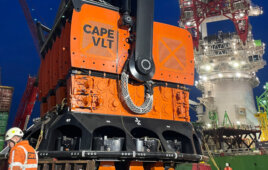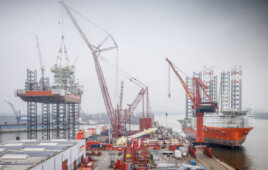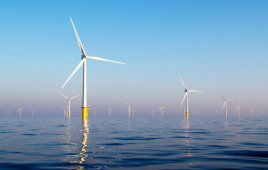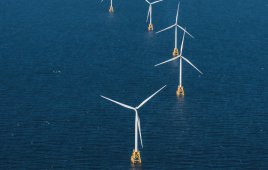
To learn more about wind turbine drivetrain technologies, go to the DOE’s wind blog. To learn more about how lightweight, high-efficiency generators will reduce the cost of energy from tall wind and offshore wind applications, see the EERE blog.
The U.S. Department of Energy (DOE) has selected four projects totaling up to $8 million to develop next-generation wind turbine drivetrain technologies that will facilitate the continued growth of turbines for land-based tall wind and offshore applications.
The aim, according to the DOE, is to develop more efficient, smaller, and lighter-weight generators that will lower costs and make wind power more affordable.
Each of the selected projects will receive up to $400,000 to design a wind turbine that can be scaled up to at least 10 MW to capitalize on the trend of larger, more powerful wind turbines, particularly for offshore applications.
Two projects are developing direct-drive, permanent magnet generator designs that are smaller, lighter, less costly, and more reliable and efficient. They also use less rare earth content than conventional gearbox designs.
- ABB Inc. of Raleigh, North Carolina will develop a lightweight double stator generator that uses an innovative advanced magnet cooling system suitable for both geared and direct drive machines, scalable up to 15 MW.
- WEG Energy Corporation of Duluth, Georgia will develop a high-efficiency permanent magnet direct-drive lightweight generator to integrate into its existing platform.
Additionally, two projects will develop superconducting generators, which make a much stronger magnetic field using superconducting windings. This results in a significant size and mass reduction over conventional generators and significantly reduces the need for foreign-sourced rare earth materials.
- American Superconductor Corporation of Ayer, Massachusetts will develop a high-efficiency lightweight wind turbine generator that incorporates high-temperature superconductor (HTS) materials to replace permanent magnets in the generator rotor, potentially reducing size and weight by 50%. The advantage of an HTS design is the higher operating temperature of the generator windings, which significantly reduces the challenges associated with maintaining supercritical temperatures in the generator. The challenge with HTS machines is that the winding material is much more expensive, and it comes in relatively short lengths, necessitating many splices.
- General Electric (GE) Research of Niskayuna, New York will develop a high-efficiency ultra-light low temperature superconducting (LTS) generator, leveraging innovations from GE’s magnetic resonance imaging (MRI) business. The generator will be tailored for offshore wind and scalable beyond 12 MW.
The advantage of LTS generators is the availability of low-cost LTS wire in lengths needed to wind the generator without splices. The challenge with LTS designs is the need to cool the windings to about 4° kelvin, which typically requires the use of liquid helium. If successful, these four research projects will result in designs up to 50% smaller and lighter while reducing the cost of wind generation by 10 to 25%.
After these four projects complete a design and analysis phase, DOE will select one project to receive up to $6.4 million to build and test a scaled prototype of their generator on a wind turbine.
Filed Under: News, Offshore wind, Projects, Turbines




